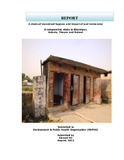Please use this identifier to cite or link to this item:
https://hdl.handle.net/20.500.14356/716Full metadata record
| DC Field | Value | Language |
|---|---|---|
| dc.contributor.author | KC, Elawati | |
| dc.date.accessioned | 2013-03-03T22:43:29Z | |
| dc.date.accessioned | 2022-11-08T10:18:55Z | - |
| dc.date.available | 2013-03-03T22:43:29Z | |
| dc.date.available | 2022-11-08T10:18:55Z | - |
| dc.date.issued | 2012 | |
| dc.identifier.uri | http://103.69.126.140:8080/handle/20.500.14356/716 | - |
| dc.description.abstract | Menstrual hygiene and management are neglected issues of Nepal. SWASHTHA project has built pad incinerator in some school of Nepal to address the need of adolescent girls. Study has been carried out in order toassess the impact of pad incinerator among school girls of four municipalities viz Bharatpur, Guleria, Tikapur and Butwal. It has also compared the differences between the situation of knowledge, practice and hygiene behavior between schools where pad incinerator were built and not built. The study is descriptive, cross sectional where both qualitative as well as quantitative methods were applied. The study was carried out with 200 adolescent girls who had menarche already, 140 girls were from the school where pad incinerator was built and 60 girls were from the school where pad incinerator was not built. The age of respondent was from 12 to 18. The mean age of girls was 15. Students were from class 5 to 10. Seventy one percent girls from Guleria, (69%) from Bharatpur, (63%) from Butwal and (43%) from Tikapur knew about reproductive health. Forty three percent girls from Bharatpur, (37%) from Butwal, (26%) from Guleria and (17%) from Tikapur knew that blood comes from uterus during menstruation. In Bharatpur, (17%) use only sanitary pad, (49%) use clothes and sanitary pad and (34%) use only clothes. In Guleria, (9%) use sanitary pad, (54.3%) use both sanitary pad and clothes and (37%) use clothes. In Tikapur, (6%) use sanitary pad and (46%) use clothes and sanitary pad and (46%) use clothes. In Butwal, (40%) use sanitary pad and (37%) use sanitary pad and clothes and (23%) use clothes. Seventy three percent girls from Tikapur, (49%) from Butwal another (49%) from Guleria and (14%) from Bharatpur leave school if they menstruate in school. In case of school where pad incinerator was not built, (93%) from Guleria, (80%) from Bharatpur another (80%) from Tikapur and (60%) from Butwal leave school if they menstruate at school. Seventy seven percent girls from Guleria, (73%) from Butwal (65%) from Bharatpur and (41%) from Tikapur used pad incinerator at school. In school where pad incinerator was not built (87%) from Butwal, (73%) from Guleria, another (73%) from Bharatpur and (60%) from Tikapur preferred pad incinerator. Similarly in school where pad incinerator was not built (100%) students are willing to buy sanitary pad, except in Guleria where (73%) were willing to buy sanitary pad. The major things achieved from this study were girls lack adequate knowledge about menstruation hygiene. Few students have access of sanitary pad. Construction of sanitary pad is not only the reason of increase attendance and decrease drop out of girls from school instead availability of pad is the major cause. However use of pad incinerator has helped students to change their pad at school which is successful to create user friendly environment. | en_US |
| dc.language.iso | en_US | en_US |
| dc.publisher | Environment & Public Health Organization (ENPHO) | en_US |
| dc.subject | menstrual hygiene | en_US |
| dc.title | A study of menstrual hygiene and impact of pad incinerator: A comparative study in Bharatpur,Guleria, Tikapur and Butwal | en_US |
| dc.type | Technical Report | en_US |
| Appears in Collections: | Post Graduate Grant (PG) Reports | |
Files in This Item:
| File | Description | Size | Format | |
|---|---|---|---|---|
| 681.pdf | Full Report. Download | 1.25 MB | Adobe PDF |  View/Open |
Items in DSpace are protected by copyright, with all rights reserved, unless otherwise indicated.
